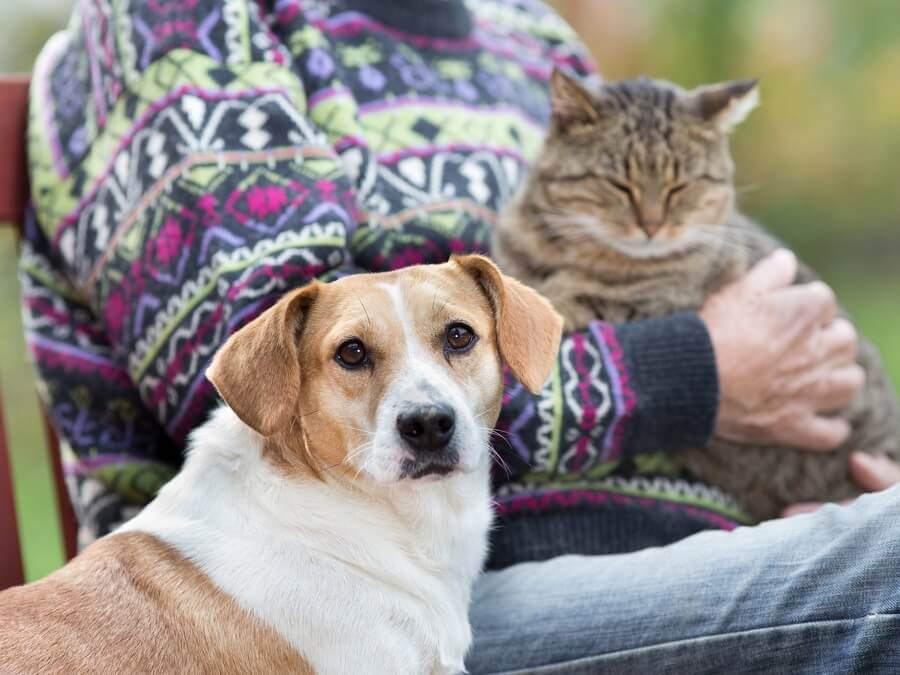As days grow shorter and temperatures grow chillier, you may notice your older pet growing a little gray around the muzzle themselves. The entire month of November has been designated “Senior Pet Month” – the perfect time of year to learn more about helping our old-timer pets spend their golden years in happy, healthy “You don’t look a day over four!” condition.
Whether your furry companion is a sleepy senior or a rambunctious retiree, take a look at these useful tips for improving your older pet’s quality of life.
Notice Signs of Aging
What exactly counts as a “senior” pet, anyway? Many organizations suggest that senior cats and dogs start around 7 years old. However, because a pet’s average lifespan can vary by size and breed, your best bet is to keep a close eye on typical signs of aging so you know when your pet needs some extra TLC.

While most people recognize outwards signs of age like gray or white fur and a more sedate pace, pets may also develop issues with sight, hearing, or age-based conditions like arthritis. You may also notice cognitive signs of aging such as pets’ forgetfulness, changes in sleeping, extra noise, and other behavior.
Fortunately, the earlier you notice that your pet’s getting a bit long in the tooth, you can start to use these strategies for supporting their mental and physical health!
Exercise Brain and Body
Older pets may not seem as spry as their younger selves, but they should get in some routine exercise to keep their joints limber, their weight stable, and their brains engaged all the same. While it’s usually advisable to avoid lengthy, strenuous walks with older dogs (and your senior cat may tap out after long play sessions), following familiar paths and games offers the combination of mental and physical stimulation pets still require.

Predictable routines are especially important for senior pets, who draw comfort from reliable schedules and activities. Older pets (especially cats and long-haired dogs) may also enjoy some extra gentle grooming, which gives them the two-for-one bonus of socializing time with you and assists with keeping their fur and paws pristine.
Give Them a Natural Boost
One simple, convenient way to support your senior pet’s health is with natural supplements. Dogs Naturally magazine offers some suggestions for scientifically-backed, helpful supplements from among the wide variety on the market.
For example, there are many supplements that research suggests will improve cognition in dogs and help tackle the effects of arthritis, such as omega-3s, glucosamine and chondroitin, mushrooms, and antioxidants like Vitamin E. Don’t neglect probiotics, either, which can help pets maintain healthy gut bacteria and more robust immune systems—both very important for senior pets.
In general, high-quality nutrition is key for pets as they age. Be sure to check in with your local independent pet store to see what supplements they have on offer!
Adjust To Their Needs
Another easy way to make your senior pet more comfortable? Tweak their environment so that it better suits the needs of an older cat or dog.

Senior pets may appear less stable on slippery floors or less able to use furniture as they age. Help them get around more securely with the addition of non-slip rugs or carpet runners, additional steps and ramps, and baby gates to block stairs or other fall-prone areas. Be sure to check in with your vet and local pet store for the best options for arthritic pets or pets with other age-related conditions.
For pets with vision loss, brightly colored runners or stickers can help direct them where they need to go—and you should try to avoid rearranging the furniture or having cluttered floors. The more standard and familiar you can keep a senior pet’s routine, the less any sudden changes will bother a brain that’s working a little harder to keep up.
Keep Them Cozy
Speaking of comfortable environments, a warm, soft bed with low sides and simple access is the perfect place for your senior pet to snooze the day away (ask your local pet store about orthopedic options!).

Make sure their bed is in a safe, secure place (like a corner) that you can also keep at a comfortable temperature all year round. Since older pets often struggle to regulate their internal temperature during normal weather changes, blankets and dog sweaters are great ways to bundle up.
There’s one more way you can help senior pets, too—even if they’re not your own. Find out what your neighborhood pet community is doing to support senior pets and their adoptions – November is also Adopt a Senior Pet Month! Even if you’re not planning to adopt a new senior pet yourself, you can share your experiences to encourage other adopters. After all, a pet is like a fine wine—they only get better with age!








